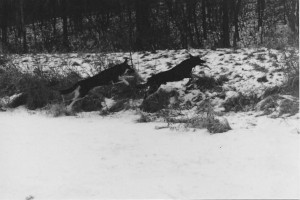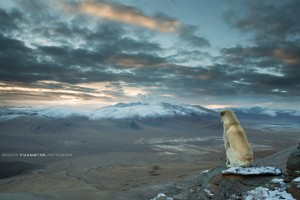The posts this week about the first section of Part Wild have made me think a lot about a wolf-hybrid I lived with in the late eighties. I thought I’d share some of my impressions of life with an Inyo-like creature as part of our ongoing discussion about the distinction between tame and domestic, and the liminality of the domestic condition.
The photos here show Alika, who was 75% wolf and 25% husky playing with my German Shepherd, Alyosha (named after the kind brother Karamazov, but known to his friends and family as “Loshy”). Anyone who has read Part Wild will recognize the wolfiness of Alika’s lithe, leggy frame and note how it contrasts Loshy’s burly, more softly contoured silhouette. They were both amazing creatures, fast friends and allies. They shared a love of big sticks, woodchucks, swimming in the pond, and doing anything the humans were doing (writing dissertations being the most common activity). And yet they were also very different, and many of Terrill’s difficulties with integrating Inyo into a domestic space rang true with my days with Alika.
Loshy was one of those incredibly perceptive dogs who never needed “training.” He was eager to please, played outfield on an intramural softball team, worked as a therapy dog in the University of Michigan hospital, and took his duties as mascot of the girl scout camp where I lived very seriously. He loved everyone but feared pizza boxes. He was a vigilant guardian of my person but would have watched quietly while thieves took my last possession.
Alika was different. (See Corinne’s reminder that we need to consider animals as individuals as well as representative of a species.) Her powers of perception could be extraordinary, but I would not characterize my interactions with her as “training.” She was extremely attentive to her “pack” of humans, domestic canines, the living room couch, and a large grey cat. She was very gentle and very shy. She ate normal dog food and whatever the campers gave to her. But she could not be confined. Like Inyo, she would destroy or thwart the most elaborate and expensive containment system out there. When we were home all was well, but if she got loose while we were gone she would run. And run, and run and run. We spent hours, sometimes days, searching for her, only to have her reappear at the camp when she thought we were home. Loshy taught her to hunt woodchucks and she taught him to chase deer. She could not fathom why the humans discouraged this activity. Unlike Inyo, she figured out a way to live in mixed company, but the part of her that was wild – intractably, genetically, evolutionarily not domesticated – eventually undid her. These old photos remind me of her gentle, ghostly beauty.
I could go on for quite a while, but will stop for now. Kara’s insightful queries about dogs’ “sixth sense” also reminded me that we still need to talk about cross-species communication. So if you get a chance, have a look at Patricial McConnell’s latest post about how humans misinterpret dog affect due to our own sign stimuli.




